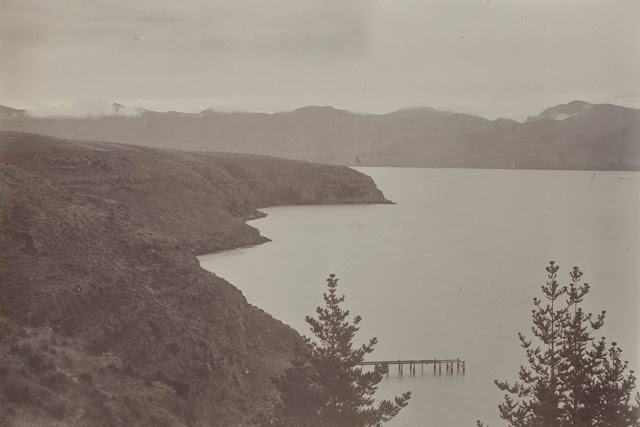Diamond Harbour #2: Cameron Brothers’ ballast quarry & jetty
There is another jetty in Diamond Harbour - derelict and disregarded, but visible from the current jetty. Until I started writing Between Land and Sea I had no idea of the history of this structure. As with all the research for this project, it’s been fun finding out.
In the early decades of the new Canterbury settlement, sailing ships that discharged their cargo at Lyttelton Port might not have a return cargo to load. Ships that were empty or lightly cargoed had to load up with ballast rocks to keep themselves stable on return journeys. There was no shortage of potential ballast in rocky Whakaraūpo. It just had to be extracted. Diamond Harbour and Church Bay, sheltered from southerly gales and ground swell, became the first main sources of ballast.
On Mark Stoddart’s land there was the sea-end of a broad lava stream flowing down from the summit of Mt Herbert. The rock, known as trachyte dolerite, broke partly in flakes and partly in prismatic blocks and was much in demand for ballast. At some point the Lyttelton businessmen John and Peter Cameron opened a wide, hard-rock quarry at this cliff-face.
The Cameron brothers had fingers in several colonial pies. In January 1861 they enlarged their already thriving retail business by opening a drapery, clothing and provision store, known as ‘The Exhibition Mart’, on Norwich Quay.[1] In 1869 they expanded their lighter fleet (which comprised the schooners Streamlet and William) by purchasing the steam lighters Mullogh and Novelty. The ‘lighters’ transported goods to and from larger ships to the wharves.[2] In a complementary business, they began, in the early 1860s, supplying visiting ships with ballast from ‘Mr Stoddart’s quarry’ (which seems to have become known as 'Cameron's quarry'). In 1876 they purchased the paddle tug SS Titan, to carry passengers to and from harbour bays. Peter Cameron was also publican of the Robin Hood Hotel which, from 1859 onwards, was pretty much the employment agency for waterfront labour.{3}
Quarrymen often worked high up on cliff faces in the ballast quarries, balancing on a rope-suspended board. They would blast the rock which then had to be broken down to manageable size on the ground, lifted into barrows and wheeled out (in the case of Cameron’s quarry) along the jetty to a waiting ballast-craft. It was a slow, heavy and dangerous job. Whether a result of the danger inherent in the job or because the Cameron Brothers, with their multiple business interests, were not the most assiduous employers, there were two deaths at the Stoddart quarry in close succession in 1879.
The first accident occurred on 30 July.
 |
| Star, 31 July 1879 |
The second accident happened just a week later.
 |
| Star, 6 August 1879 |
It may have been that these deaths, as well as changes in the nature of shipping and cargoes, precipitated the closure of the quarry since the wharf was little used after the 1880s.
Oliver Hunter described the ballast-craft that would take the rock from the quarry jetty to ships at the port, as solidly built ketch-rigged vessels of up to 25 tons. About 30 feet long and 10 feet in beam, they were built of hardwood coated with coal-tar.[4] Despite being poorly regarded by those with 'superior' boats, the tough little ballast-craft had their own moment of glory in the New Year’s Day Lyttelton Regatta.
 |
| Lyttelton Times, 11 May 1871 |
 | ||
Star, 2 January 1875
The next post will resume the story of the main Diamond Harbour jetty post-1874.
|
[1] Lyttelton Times, 9 January 1861
[2] Press, 30 April 1869
[3] Gordon Ogilvie, Place Names of Banks Peninsula and the Port Hills. Christchurch: Canterbury University Press, 2017
[4] Oliver Hunter, The Magnostic Philosopher of Church Bay. Friends of the Diamond Harbour Library, 2006.
[3] Gordon Ogilvie, Place Names of Banks Peninsula and the Port Hills. Christchurch: Canterbury University Press, 2017
[4] Oliver Hunter, The Magnostic Philosopher of Church Bay. Friends of the Diamond Harbour Library, 2006.







Comments
Post a Comment